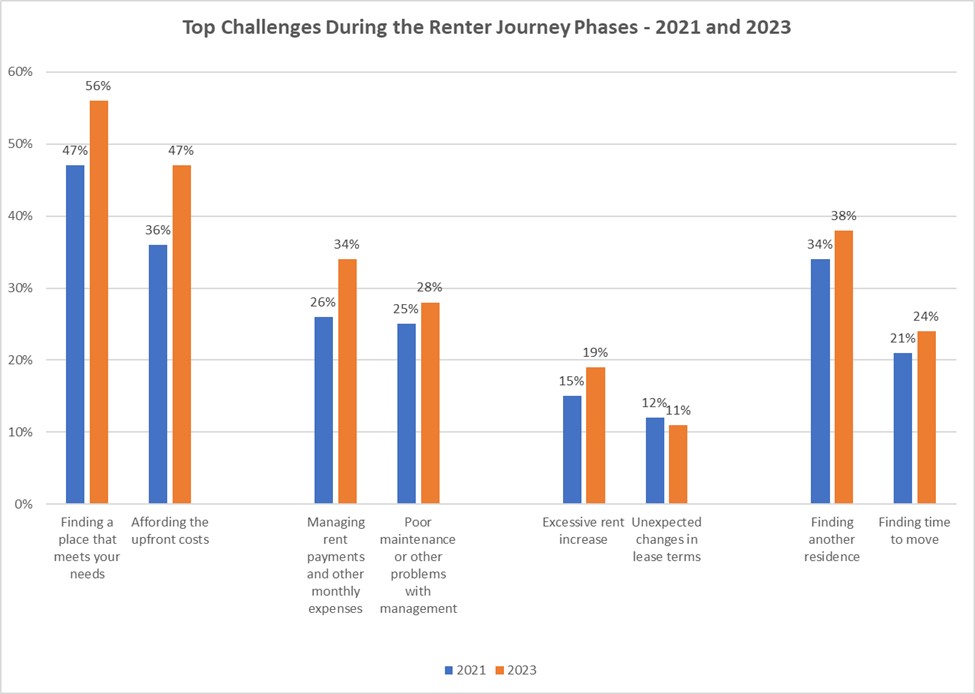Fannie Mae Research Identifies Challenges Faced by Today's Renters
About one-third of all households in the United States, or 45 million households, are renters. And their struggles are intensifying – and aren't just limited to their monthly rent bill.
Those are the findings of a recent survey, commissioned by Fannie Mae, to better understand the changing needs and pain points of people who rent their home. The survey of more than 2,500 renters was conducted last year and followed a similar survey in 2021. The results showed that overall affordability and the difficulty of finding a home that meets their needs were among renters' greatest concerns. That's not surprising, given the inadequate supply of rental housing that exists in many markets in the United States. As of 2022, about half of all renters – over 22 million households – were cost-burdened, that is, spending more than 30% of their income on rent and utilities.1 However, a typical renter's challenges don't end there. Highlights of the findings are:
- In addition to finding a home that meets their needs, many renters said a top challenge was finding the cash for upfront costs, such as the fees for an application and the security deposit. Thirty-four percent of respondents said this was a top concern in 2023, compared with 26% who said so in 2021.
- Other concerning and frequent challenges include unexpected changes in lease terms at renewal, the inability to use rent payments in building credit history, and difficulty and delay in getting security deposits returned.
- Most renters reported they are not very knowledgeable about their rights as renters.
- Black and Latino renters reported a greater likelihood of experiencing certain challenges, particularly when it comes to rental application rejections, unexpected fees, and use of housing vouchers.
- A majority of renters (63%) said that their relationship with their landlord is somewhat positive or very positive.
A full overview of the survey's findings can be found here.
Renters are the ultimate beneficiaries of the properties financed by Fannie Mae's Multifamily business. Challenges in renting can have immediate and long-term impacts on people's quality of life – property condition, safety concerns, and living paycheck to paycheck affect health and well-being. Lack of sustainable and affordable housing makes it harder to save and attain the financial wherewithal – including establishing credit – to build wealth and stability.
Notably, about a third of renters are "permanent renters," who plan to rent indefinitely, either by choice or by circumstance. Understanding who they are, what their needs are, and how to reduce obstacles to stability, affordability, and habitability is one way Fannie Mae is working to make the housing system more responsive to the emerging needs of the families we ultimately serve, whether they rent indefinitely or plan to purchase a home in the future.
To learn more about their challenges beyond affording rent, we surveyed 2,550 members of the general renter population, including statistically significant samples for low- to moderate-income renters and those in historically underserved groups. Repeating the survey allows us to track these findings over time, as economic challenges continue to impact households across the country.
Renter Journey Findings
Each phase of the renter's journey presents different challenges and obstacles. In our survey, we asked renters to cite their top challenges at each of four phases: before moving in, during the lease, during lease renewal, and when they move out. In comparing our 2021 and 2023 survey findings, we saw that the challenges that renters are facing remained the same, but in 2023, more renters experienced these challenges, especially the financial challenges like affording upfront costs and managing monthly rent. In addition, we found that renters in different demographic groups experience similar challenges and pain points, but Black and Latino renters are more likely to experience certain pain points more often.
Figure 1 shows the top two pain points during each phase in 2021 and 2023 for all renters surveyed, along with the percentage of respondents who said each was a challenge:
Figure 1: Top Challenges During the Renter Journey Phases – 2021 and 2023
Click image above for larger view
Challenges Before Move In
Our research confirmed some things we already knew from market and demographic research regarding affordability — "Finding a place that meets your needs" (including budget) and "Affording upfront costs" (security deposit, first and last months' rent, and application fees) are the top two pain points. These findings were similar across demographic groups.
Certain other challenges are more common for Black and Latino renters. For example, Black and Latino renters are more likely to have had a rental application turned down (41% and 33%, respectively), compared to white and Asian renters (29% and 24%, respectively). For all renters, "not passing the financial or credit check" was the most cited reason for having an application turned down.
Challenges During Lease
Affordability challenges continue for renters once they are able to find a rental home. "Managing rent payments and other monthly bills and/or expenses" is the top challenge during the lease for all demographic groups, and this percentage grew from 26% to 34% in 2023. Unsurprisingly, then, in the 2023 survey, more renters reported missing a rent payment – 33% in 2023, compared to 27% in 2021.
In addition to affordability, other areas where renters experience challenges during the lease include:
- Habitability – 28% cited "Poor maintenance of the unit and/or building or other problems with property management" as a pain point. This was similar for all demographic groups.
- For that 28% who cited maintenance and upkeep as a challenge, the most common challenges were pest problems, structural issues, air conditioning or heating problems, and high utility costs due to old or inefficient appliances and fixtures.
- Safety and security – 12% of renters overall said this was a concern, and this was more common for Black (14%), Latino (13%), and Asian (15%) renters as compared to white renters (9%).
In this section we also asked renters about their knowledge of renter rights. A majority of renters (64%) said they only know a little or nothing about their rights.
As mentioned above, in the "Move in" phase many renters have had their applications rejected due to insufficient credit. Therefore, in this section, we asked renters if they would want their rental payment history to be reported to a credit bureau to help them build their credit score. Seventy-two percent of renters said they would opt to do so given the opportunity.
Challenges During Lease Renewal
Renters have fewer pain points during the lease renewal phase, but there were still some important findings. The most frequently cited challenges at lease renewal were "Excessive rent increase" (19%) and "Unexpected changes in lease terms" (11%). Both of these challenges impact renter stability. Sixty percent of renters said they did not face any challenges at lease renewal.
Challenges During Move Out
When households are moving, they have to deal with the move out process, on top of the challenges of finding and moving into a new home. Therefore, it is not too surprising that the most cited challenge at this phase for all groups was "Finding another residence" (38% of renters). "Finding time to move" was the second most cited (24% of renters), followed by "Return of security deposit" (19% of renters). These were similar for all demographic groups. For those who cited challenges with the security deposit, the most cited challenges were not getting the full amount back and the return taking too long. These issues could greatly impact a household's ability to cover the upfront costs when looking for a new rental.
Most of the challenges during this phase were similar across demographic groups, however Latino renters are significantly more likely than white renters to be challenged with finding time to move (27% of Latino renters vs. 20% of white renters), dealing with move-out logistics (15% of Latino renters vs. 9% of white renters), and dealing with unexpected extra charges at move out (14% of Latino renters vs 9% of white renters).
Top Pain Points for Renters
In the final portion of our survey, we asked renters to compare pain points across the entire renter journey from search to move out (using the Duo MaxDiff methodology, which ranks items based on two dimensions – most concerning and most frequent).2 In developing our survey, we accepted the assumption that basic affordability would be the top challenge for many renters. We wanted to learn more about challenges beyond that as we consider new strategies to help renters. The pain points that renters reported as being both the most concerning and most frequent were:
- Affording the upfront costs
- Insufficient notice about expected future rent increases at renewal and for future years
- Not getting all of my security deposit back, the documentation for off-sets, or a delay in getting it back
- Unexpected changes in lease terms at renewal
- I don't know my rights as a renter and don't know what do to if my rights are violated
- My rental payments don't give me the opportunity to build my credit history
We did this analysis in both 2021 and 2023, and the top three pain points remained the same. The next three pain points shifted up or down one spot. These high-priority pain points were similar for renters across racial groups and income levels.
Conclusion
This research confirmed that overall affordability is the biggest challenge for all renters, but also highlighted the need to address other aspects of the renter experience that can lead to housing instability and make long-term housing security more difficult – difficulties that can affect Black and Latino renters more frequently and acutely. As we and our industry partners work to provide affordability and stability, these findings can help us prioritize the most pressing renter needs and inform our work to address them.
See our full report from the 2023 Renter Needs Research.
1"More Than 42 Million Us Households Were Cost Burdened In 2022"; Housing Perspectives Blog, January 19, 2024. Joint Center for Housing Studies of Harvard University.
2 A Duo MaxDiff is a variation of the traditional MaxDiff methodology. It maximizes insights by asking respondents to make a choice based on two dimensions of interest instead of one, in this case most frequently experienced and most concerning. The full analysis is included in the research findings deck, starting on page 59.


